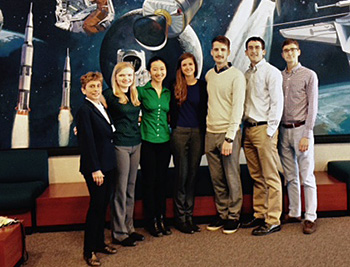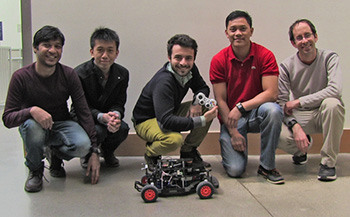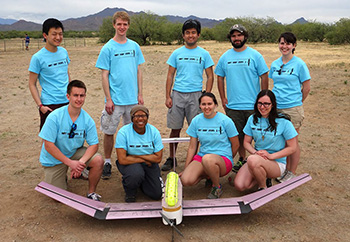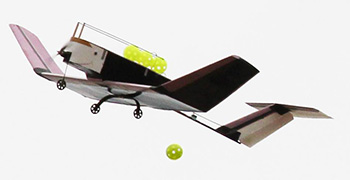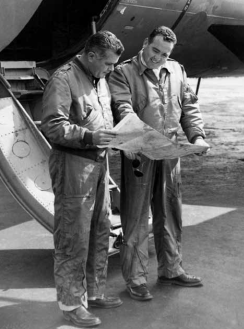
May 2015In this issue: |
|||||||||
|
|||||||||
|
|||||||||
 |
 |
Dedoussi |
Parandehgheibi |
Professors Steven Barrett and Sertac Karaman have been awarded Singapore Research Professor Chairs for 2015. AeroAstro Professor and Singapore MIT Alliance for Research and Technology CEO/Director Dan Hastings called the awards "a well-deserved achievement."
 |
.jpg) |
Barrett |
Karaman |

Wardle

Shah

How

Wang

Crawley

Willcox
3. Newsnotes
Professor Brian Wardle has been promoted to full professor. Wardle is an international leader in the design and fabrication of nano-engineered multifunctional advanced composites. Professor Julie Shah, an expert in integrating robots into human team environments, and Professor QiQi Wang, an expert in high fidelity simulation methods and chaotic systems, have been promoted to associate professor without tenure. The promotions are effective July 1. Congratulations to all three.
Professor Ed Crawley, System Architecture Lab director Bruce Cameron, and AeroAstro alumnus Daniel Selva (AeroAstro PhD '12) have authored the new book "System Architecture: Strategy and Product Development for Complex Systems." The publication focuses on capturing experience and analysis about early system decisions, and how to choose architectures that meet stakeholder needs, integrate easily, and evolve flexibly. It includes case studies by leading practitioners in fields such as hybrid cars, communications networks, and aircraft. Cameron says that the book is the product of 20 years of System Architecture Lab research and teaching.
Professor Jon How has been named editor-in-chief of IEEE Control Systems Magazine, the largest circulation technical periodical devoted to control systems. The magazine publishes tutorial and expository articles on all areas of control system design and applications.
Professor Emeritus Leon Trilling writes to tell us he organized a science workshop for 7th and 8th grade Passamaquoddy youngsters in Maine. The workshop engaged 24 students divided into three teams, which were led by three local teachers and three MIT students acting as TAs. It was a joint enterprise of MIT, Maine Indian Education, and the Moosehorn National Wild Life Refuge, the latter's staff leading a hands-on study of the role of water in the natural environment, while the staff of the town of Calais demonstrated the use of water in an urban context. MIT has been invited back; Professor Wesley Harris will lead an expanded workshop this summer.
Professor Karen Willcox is co-leading MIT's new Online Education Policy Initiative, an offshoot of a recent task force on the Institute's future. Funded by a Carnegie Corp. grant, the initiative will release reports, host workshops and lectures, and make recommendations about online learning.
Fabrice Kunzi (SM '11, PhD '14) reports that he and former AeroAstro professor Annalisa Weigel (SB '94, SM '00, PhD '02) are hard at work at a new company, Panoptes Systems, creating affordable, commercial obstacle avoidance products for small drones. Founded in 2014 as an Aurora Flight Sciences spinoff, Panoptes is focused on the mission of giving small drones “all-seeing” awareness of their flight environment, enabling their safe and efficient operation for commercial applications. They recently launched their first product, the "eBumper," which they say is the first commercially-available, sonar-based, small drone obstacle avoidance system for low-speed and indoor operations.
4. In the picture
For the eleventh year, the Kennedy Space Center hosted AeroAstro students to learn about the importance of “operable” design. The program is conducted by the Mass. Space Grant Consortium during IAP. The internship enables students to learn about processing of shuttle, ISS, and launch vehicles. Pictured at the space center are (from left) Space Grant co-director Raji Patel and students Ashley Carlton, Connie Liu, Caitlin Kerr, Michael Kasperski, James Byrne, and Matt Vernacchia.
16.64 Flight Measurement Lab Seminar students (from left) Martin York, Nicholas James, Nate Colgan, and Matt Deyo prepare for a helicopter hover performance test at Hanscom Field last month.
A new activity offered during January’s IAP showcased fully autonomous 1:10-scale model cars navigating through MIT's underground tunnels in a robot race. Students (from left) Abhishek Agharwal, Jason Ma, Valerio Varricchio, John Alora, and postdoc Guy Rosman pose with their robot vehicle. You can read about the activity in an article on MIT Campus News.
5. In the face of adversity, DBF Team shines
AeroAstro senior Casey Denham, MIT Design-Build-Fly team president, provides this wrap-up of the 2015 DBF competition:
The 2015 AIAA/Cessna/Raytheon Design/Build/Fly competition was held April 10-12 in Tucson, Ariz., and the MIT team placed ninth out of more than 60 international teams attending the event!
This year's competition featured a sensor-carrying mission in which the aircraft carried a five-pound payload, and a sensor dropping mission in which the aircraft dropped one wiffle ball per lap. The speed of the payload loading and the aircraft weight were factored into the overall score. The team received the third highest report score, with a score of 95.0 - the highest report score the team has ever had!
Although we were one of the lighter teams at the competition, we suffered a devastating crash Friday afternoon, destroying the entire fuselage and part of the wing. The team spent the rest of the day Friday and Saturday rebuilding, and were able to successfully complete the remaining two missions. We are extremely proud of our results, given that we did not have an airplane for almost half of the competition, and of the extraordinary teamwork that went into the rebuild. The 2015 MIT DBF team members were Adam Woodworth (pilot), Tony Tao (G), Giulia Pantalone (G), Casey Denham (Sr.), Mari Prescod (Jr.), Rachel Harris (Soph.), Allan Ko (Soph.), Colleen Madlinger (Soph.), Jonathan Zdasiuk (Soph.), Sara Gonzalez (Soph.), and Ronnie Odgen (Fr.).
Without the support of our sponsors, the AeroAstro Department, and our graduate and faculty mentors, the MIT DBF team would not be able to design and build the consistently high-quality planes that we love to make. Thank you for allowing us to have these experiences for yet another year!
The 2015 MIT Design-Build-Fly Team with its aircraft.
The DBF team's plane drops a wiffle ball.
6. "Chip" Collins, Doc's pilot, passes away at 95.
Few in the department are aware that we once had an official staff pilot. That man was Col. Charles "Chip" Collins, who passed away earlier this year at the age of 95. Trained in fighters and bombers, he became an expert B-29 pilot and had not a few adventures flying the Superfortress on 3,000-mile missions (in an aircraft with a 220 mph cruise speed). Late in the war, he met Charles "Doc" Draper who eventually hired him to establish a flight component of the MIT Instrumentation Lab. Chip was the pilot in command of the B-29 Doc used for the 1953 first cross-country flight navigated solely by inertial reference. During his career, he participated in the development and flight testing of subsequent inertial navigation systems leading to successful applications in civilian and military aircraft, space exploration, and missile defense for such programs as NASA’s Apollo Moon Program and the U.S. Navy’s Fleet Ballistic Missiles — Polaris, Poseidon, and Trident. He piloted the Digital-Fly-By-Wire test flight in the 1970s which demonstrated the advancement of flight control from analog to digital flight control. He was also was a regular Course 16 guest lecturer. An excellent retrospective of Col Collins' career and adventures appears on the Aero News Network website.
Chief Test Pilot Chip Collins (right) and co-pilot Dave Buxton review flight path prior to an Instrumentation Lab inertial guidance test flight. (Draper Laboratory)
Follow AeroAstro
Don't wait for your enews and emails — keep up with AeroAstro news as it happens — follow the department on Twitter and Facebook.


